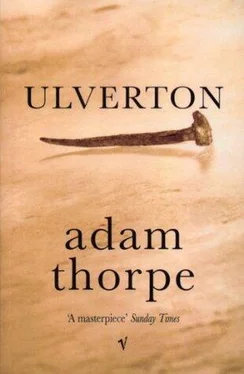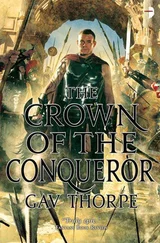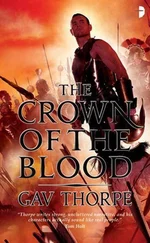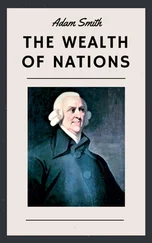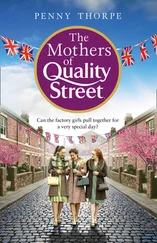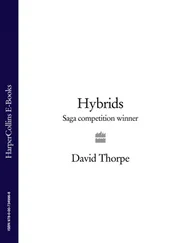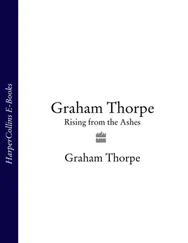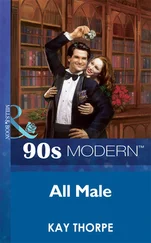For the frost being severe that January, I noted how, the thick rime on the roofs having melted, the released water ran down to the very tip of each inclined stalk of straw that had been its host — and hung there, as if the simple thatch was unwilling to release its sudden adornment: when the sun shone, as it did frequently that crisp winter, the whole glittered with a beauty beyond compare, transforming what was sullen and coarse into a sublime perfection. I made several studies of this phenomenon, but I have included here the one which, however inadequately, comes closest to capturing that bejewelled effect — as the Dutch painters once caught the sheen of silk, or the exquisite hint of canker in a peach’s bloom, upon their small canvases.
Plate XXIX ACROSS THE DOWNS
No more suggestive subject than an ancient road, redolent of the past! Here the main highway from our village, where it rises up across Mapleash Down, has served my purpose. If the reader wishes to photograph a road — whether the broad confidence of an old turnpike, or the meddlesome ruts of a track — then choose a day after rain, when the sun is out, but the earth still moist: then see, as here, how the way gleams with a silvery tone, up to the farthest horizon, if the sun be before you, but not so directly in front as to blind. No longer are the pools and brimming ruts a menace to polished shoes, a trial to the scrubbed gig, a curse on the coachman’s coat-tails: to the enthusiastic photographer these silver islands are like beacons to a better world, for they lead the eye of the viewer towards the far hills, the distant copse, the shadowy combe: those horizons that speak of sublimities, though the path be hard and long.
On either side, you may notice, the turf of the downland pasture is lacking in details, and dark: but this is quite deliberate, for the road then shines with greater contrast, its curving nature sinuous as the scales of a serpent. Indeed, keeping in mind the very conditions of light essential to the effect, this chiaroscuro can hardly be avoided. The great oak upon the right, known popularly as Sam’s Throne, its trunk conveniently splashed with the chalk, gives weight and interest to the middle distance, which might otherwise be too sparse — while the glint of the iron catch on the gate in the far distance was, I am content to confess, a happy accident.
You may wonder why it is I have no human interest in this picture — no weary pilgrim leaning against the tree, or plodding his hedge-shadowed way. It is imperative to remember that a human interposition immediately subsumes any sublime feeling in a work; there is a kind of sublime melancholia, I suggest, here present, that arises out of the suggestiveness of a presence just around the corner, or about to come into view — for no road is made for anything other than human passage. If that passage be absent, as here, how pure and clean becomes the metaphor! The spectator is drawn towards his own destiny, in which no one truly shares but our watchful Creator. Only the passing of past generations resounds in all its invisible ghostliness — the tramp of legions, the earls on their palfreys, the peasants bent under their faggots — while those generations to come, the snorting of traction engines and the whip-cracking chaises, lurk in the shadows of Destiny.
Plate XXX THE BLACKSMITH’S SHOP
Here, under the great and cooling shade of the chestnut, Frederic Moon plies his ancient trade. In the long-ago past of pagan mystery, the Evil One passed near Ulverton, and demanded of the smith his service: the smith declined to shoe those terrible hooves, and was turned to stone. The Devil thereupon limped away, leaving his mark in a curious depression on Louzy Down, that the less imaginative say was the quarry for our White Horse (see Plate XV, ibid .), that canters (albeit somewhat grey and brambled) upon the same slope. The stone rests, rain-worn, but still (from a north-easterly angle) shaped like a man bent over an anvil, on the brow of a nearby hill, and rare is the villager that dares approach it at full moon, when the forlorn striking of iron on iron is said to echo across the vale.
Happily, in these Christian times, Mr Moon (coincident name!) is asked to cradle nothing more terrible than a nag’s leg, as here he is doing. Alas, no amount of cajoling can persuade a horse to keep its head from moving, or tail from swishing, however firm the hand upon the bridle — and Mr Moon’s strapping assistant, Master Harry Dimmick, did all in his powers to still the beast. The trestle, grindstone, and other sundry items were purposefully arranged, as in a painter’s canvas, to please the eye — much to the amusement of the fellows, who were more used to tossing their tools onto the most convenient spot at hand! Indeed, I requested that the rain-barrel against the wall could be shifted more firmly to the right of the picture, thus counter-weighting the window on the left, but they claimed (in great consternation) that it instantly, and without hesitation, would fall apart, and its precious liquid (this was late summer) be given to the dust.
The older folk, on viewing this operation, were heard to remark how the village was without a smithy for a full year, some thirty-odd years ago. On requesting the reason for this improbable occurrence, I got little satisfaction beyond a few murmurings of ‘that trouble’, or ‘that gurt black day’, until one old dame of great spirit informed me that, ‘old Dick Bowsher was transported for seven year, an’ passed away out yonder, poor soul’ — to a silent applause of slow nods and grim faces. Mr Bowsher being the village blacksmith, and accompanied on his sad voyage by several other fine bodies from the locality (their leader, a Mr Oadam, having been dealt with capitally), no replacement was to be had (or, I venture to suggest, desired) and the smithy fell almost into ruins. The crime of said persons? A desire for living wages, and a fear of machinery, that sprang forth in those riots of some thirty years ago, that caused the nation such alarm, but were snuffed out with a ferocity one can only feel belongs to less civilised nations (see Plate XXXIV, ibid .), and that has not brought any marked improvement in the lot of our poor John Hodges.
Plate XXXI AFTER THE HARVEST
Again, I draw the reader’s attention to the minute particulars in our surroundings — whether they be rustic or urban — that serve the photographer so efficaciously. This is, indeed, an Example whose title exercises that faculty in the viewer, and once exercised, I venture to hope that the said viewer will depart into the world with a surer eye. For where, you might ask, is the subject? Here is another road (I am partial to roads) and there is a part of a field, and hedgerows, and a clear sky (those sooty black specks are not the outcome of mishandling, but are passing birds — many the image marred by those spirited creatures!) with a farm of picturesque quality in the near distance, sunk under its four great elms (it is known, in the appealing way of country nomenclature, as Five Elms Farm) — but where is the rustling, creaking haywain? Where the dust of the bringing home? Where the rosy-cheeked children riding the stack?
But look more carefully: something has, indeed, passed this way. It is early morning, and the low sun before us lights the track: the track is dry, and absorbs the light. But there is something other, some strewn matter, that does not absorb — that appears to rejoice in the sun; as if its gleam is a welcome, a memory of happier, golden times — before the fall upon dull ruts, or the hook of the eager hawthorn bough! The textural properties of this matter make of it something like precious metal, gathered by passing wheels into the middle part of the road, where it resembles (in actuality) a golden spine, or a long lock of Rapunzel’s hair, with its sheen woven into the distance — but likewise immediately puts one in mind of the mental track, with its golden thread of higher effort, that can so easily be blown into disarray by the gusts of fate and bitterness.
Читать дальше
